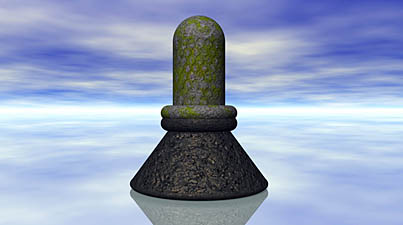
Primitive Hill. Navel of the World. Axis Mundi. House of God.
In
various creation stories there is the concept of the first land arising
from the waters. This first land is called by different names. In
Sumerian and Babylonian it is the primitive hill or primitive mountain
and recognized through the worship of the sacred stone in other
cultures. In Egypt
this stone is the Benben, in Greece it is the Omphalos, in Rome it is
the Baetyl and in Hinduism it is the Shiva linga. It also later became
popular throughout the Levant in Phoenician cities like Sidon, Byblos
and Tyre. This sacred stone
that was worshiped has other mythologies and symbolism attached to it.
It would include the axis
mundi,
world tree (Tree of Life), birds, serpents and fire. Historians say
these
stones because of certain descriptions by the ancients are assumed to
be meteorites
and therefore the association to fire. This may be true for some but
not
all. The Omphalos at Delphi was a stone and not a meteorite. It marked
the center of the Hellenic world. The black stone from the Temple of
Aphrodite in Cyprus is what is called an aniconic black stone which is
not a meteorite. Today such
a stone is part of the Muslim religion. It is housed in the black
shrine in Mecca, the Kaaba, and is named al-Hajar-ul-Aswad. It was sent
by Allah and landed in the paradise of Adam and Eve. Adam then built
the Kaaba as a replica of Allah's house in Heaven. In Sumeria it was
at creation that the primitive mountain arose from the primordial sea
when earth and Heaven were separated. An was Heaven and Ki was the
earth. In later Babylon it was on the primitive hill that the king
stood within the axis
mundi.
The Egyptian myth had Atum standing on the Benben during his act of
creation. Shiva's fiery linga which broke up from the nether world is
the axis mundi
and is the first linga from which Shiva emerged. The concept of the axis mundi
is world wide and an explanation of its various meanings and symbols
can be found at: http://en.allexperts.com/e/a/ax/axis_mundi.htm. The
concept of the baetyl predates Shiva and can be found in the Indus
Valley civilization.
"I distinguish three types of cult stones at Mohenjo-daro – and Harappa – the baetylic, the phallic and the yoni ring-stones. Each of these types is represented by numerous examples, both small and large, the former much predominating over the latter... On the other hand, it is probable that they were originally distinct from baetylic worship, which is found frequently connected with the cult of the Mother Goddess among the oldest tribes, whereas phallism is rarely, if ever, found among these aboriginal people." (Marshall 1931:63) By Gregory L. Possehl: http://www.scribd.com/doc/22597545/09-The-Indus-Civilization
The baetyl ultimately was the House of God - a Beth-El. These stones were venerated as having the god living or the god's soul residing within the sacred stone. They were believed to have supernatural powers as in giving the gift of prophecy. The word itself seems to be both Mediterranean and Semitic in origin. As a historical note the term baetyl for the first time was used by the author Pliny the Elder.
The stone's connection to birds: the omphalos has two - one on either side - and the Benben has the Bennu bird. The Benben does not seem to have been a geodetic marker on the order of the omphalos but rather a marker of where it all began. The Benben was the original primitive mound represented as a pyramid shaped stone and the dwelling place of the sun god with its association with the Bennu bird (also Benu bird). This is documented in the Egyptian Pyramid Texts. The Roman Baetyl also has bird associations. It was protected by an eagle which can be seen standing in front or on top of the stone on some Roman coins.
"I distinguish three types of cult stones at Mohenjo-daro – and Harappa – the baetylic, the phallic and the yoni ring-stones. Each of these types is represented by numerous examples, both small and large, the former much predominating over the latter... On the other hand, it is probable that they were originally distinct from baetylic worship, which is found frequently connected with the cult of the Mother Goddess among the oldest tribes, whereas phallism is rarely, if ever, found among these aboriginal people." (Marshall 1931:63) By Gregory L. Possehl: http://www.scribd.com/doc/22597545/09-The-Indus-Civilization
The baetyl ultimately was the House of God - a Beth-El. These stones were venerated as having the god living or the god's soul residing within the sacred stone. They were believed to have supernatural powers as in giving the gift of prophecy. The word itself seems to be both Mediterranean and Semitic in origin. As a historical note the term baetyl for the first time was used by the author Pliny the Elder.
The stone's connection to birds: the omphalos has two - one on either side - and the Benben has the Bennu bird. The Benben does not seem to have been a geodetic marker on the order of the omphalos but rather a marker of where it all began. The Benben was the original primitive mound represented as a pyramid shaped stone and the dwelling place of the sun god with its association with the Bennu bird (also Benu bird). This is documented in the Egyptian Pyramid Texts. The Roman Baetyl also has bird associations. It was protected by an eagle which can be seen standing in front or on top of the stone on some Roman coins.

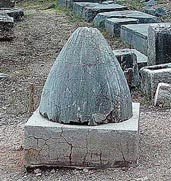

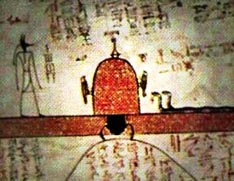
The omphalos as the "navel of the earth" marks the terrestrial center from which all points are determined. Thus the parallels and meridians were measured from it - which in ancient Egypt the center was at the Temple of Amun. It marked the spot of the axis mundi which determined the cardinal points of the compass. This center ruled immense power both religious and political. In fact when the Babylonians ruled Mesopotamia they declared Marduk's temple as the axis mundi dethroning Enlil - a top pantheon god. That was quite a feat and they were successful. The Assyrians tried the same thing but were not able to accomplish what the Babylonians did.
 In
India the Shiva linga is considered
an omphalos. Its shape can
be conical to phallic and be made from a variety of materials. The
Shiva linga has a complex symbolism including the axis
mundi
and as with other omphalos the serpent and fire are also other aspects
of the linga. It has a direct connection to the Hindu god Shiva and is
his sign as well as a fertility symbol. The
Sanskrit word Shiva is an adjective meaning kind, friendly, gracious or
auspicious. As a proper name it means "The Auspicious One". Shiva also
has an association with serpents and the trident called the Trishula of
Shiva. The trident is also a symbol of Poseidon the Greek water god who
if
you go back far enough to an earlier time is Enki.
In
India the Shiva linga is considered
an omphalos. Its shape can
be conical to phallic and be made from a variety of materials. The
Shiva linga has a complex symbolism including the axis
mundi
and as with other omphalos the serpent and fire are also other aspects
of the linga. It has a direct connection to the Hindu god Shiva and is
his sign as well as a fertility symbol. The
Sanskrit word Shiva is an adjective meaning kind, friendly, gracious or
auspicious. As a proper name it means "The Auspicious One". Shiva also
has an association with serpents and the trident called the Trishula of
Shiva. The trident is also a symbol of Poseidon the Greek water god who
if
you go back far enough to an earlier time is Enki.
 To
the far left is an omphalos stone from Ireland. It is called the Turoe
Stone and dates from 150 BC to 250 BC. The shorter stone is the Castlestrange
stone.
To
the far left is an omphalos stone from Ireland. It is called the Turoe
Stone and dates from 150 BC to 250 BC. The shorter stone is the Castlestrange
stone."Standing at around 3 feet high the granite boulder known as the Turoe stone is a beautifully decorated phallic stone, the top half is covered with a curvilinear design typical of the Celtic art style known as La Tene, this dates the stone to around the 1st to 3rd centuries B C, the middle is decorated with a form of Greek key. The patterns are carved in relief using a technique known as poking." (http://www.megalithicireland.com/Turoe%2520Stone.htm)
"Along the side of the farm drive in the grounds of Castlestrange Demense stands this beautifully inscribed Cult stone, decorated with curvilinear ornament and dating to around 200 BC. At 60 cm high and approx. 90 cm long, it sits on a round bed of radially placed river rocks which in turn is surrounded by a protective cattle grid. While the function of these cult stones is not clear, it is presumed that they had a ritual or religious purpose. (http://www.ancientireland.org/castlestrange/index.htm)
Baetyl Handles
The omphalos is also known by its Latin name Baetyl and tends to look more like a tall pyramid. The images below are from Roman coins and show a winged angel on one side and on the reverse the baetyl stone. What is peculiar about these images is that the baetyl has handles on it. The first three have a handle on each side at the top. The fourth and fifth coin have a different rendering for these handles, more like knobs, and located at the top. If the baetyl does in fact come from the Egyptian Benben stone and thus the pyramidion, then it hearkens back to the winged disk and the "handles" that also appear at the top of the disk. It then would reinforce the concept that the "pointy object" could have been a container that opened and closed. Many of the images of the winged disk also had two handles.

What
also raises questions is, why is this angel on the obverse
of all the coins above? Same kneeling pose with the wreath and what is
called a caduceus is another question. Why a caduceus? It may be a nod
to the symbolism of the Tree of Life. Most Roman coins depict an
emperor. Also on both sides of the baetyl
are the two birds (but could be grapes) associated
with Greek and Egyptian omphalos stones. The only thing missing is a
serpent. Some coins without baetyl handles do have an emperor on
the obverse
side.
Tree
of Life
Here are three coins with associating the Tree of Life with the sacred stone. The first coin shows the classic fleur design for the leaves and fruit. The twin stones may depict a pair of oracle stones which was common at that time but these still are considered baetyls. Oracles were associated with the baetyl. The second shows the Tree growing from the baetyl itself much like the world tree growing from the primitive hill and the last is Greek with the typical Fleur-de-Lys symbol for the Tree of Life growing from the top of the omphalos. It is curious that the head of a bird is on the obverse side of this coin.
Here are three coins with associating the Tree of Life with the sacred stone. The first coin shows the classic fleur design for the leaves and fruit. The twin stones may depict a pair of oracle stones which was common at that time but these still are considered baetyls. Oracles were associated with the baetyl. The second shows the Tree growing from the baetyl itself much like the world tree growing from the primitive hill and the last is Greek with the typical Fleur-de-Lys symbol for the Tree of Life growing from the top of the omphalos. It is curious that the head of a bird is on the obverse side of this coin.
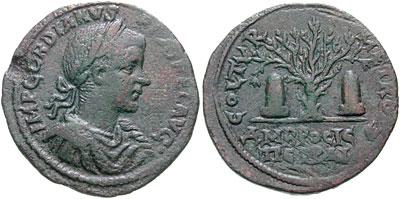


The Crease
There appears on some coins a crease at the top of the baetyl. The three coins below have an indication of a crease. The first two coins have an obvious crease. The coin to the far right has a faint line on the same diagonal and at the same height as the other two coins. This diagonal crease at the top of the baetyl with the same slant and location indicates it is intentional. To me it looks like a hatch but you can draw your own conclusion. Since it shows up on three of these coins there must be some unknown symbolism connected to it. Of all the coin pages I have visited not one makes any reference to it, the handles yes the crease no. The last is a mystery. It looks like three poles with an undefinable object inside.

Axis
Mundi
The coins below are even more curious in that they seem to show that the baetyl has an interior and that although this sacred stone is presumed to be solid yet there is something mysterious going on inside. It is as if the outside skin has been rendered open to reveal some sort of structure. Four of the five coins show a pole or strut. Notice at the top how the outside wraps itself over the internal object/structure of the second coin. The mundane answer to this pole could be and most likely is the axis mundi. These coins may be telling us something conneted with the baetyl in a mystical way that in reality does not belong there as these stones in real life were solid clear through. The baetyls did not have a pole inside them nor a skin that could be torn open. All of these coins also have the angel on them.
The coins below are even more curious in that they seem to show that the baetyl has an interior and that although this sacred stone is presumed to be solid yet there is something mysterious going on inside. It is as if the outside skin has been rendered open to reveal some sort of structure. Four of the five coins show a pole or strut. Notice at the top how the outside wraps itself over the internal object/structure of the second coin. The mundane answer to this pole could be and most likely is the axis mundi. These coins may be telling us something conneted with the baetyl in a mystical way that in reality does not belong there as these stones in real life were solid clear through. The baetyls did not have a pole inside them nor a skin that could be torn open. All of these coins also have the angel on them.


 The
Sphere
The
SphereThese images are baetyls. Although the first two are fairly rough looking these two coins have what appears to be a sphere coming out of the apex of the baetyl. Even in the more worn coin the sphere is easily discernible. Once again it is located at the top along with the handles and crease. The kneeling angel is on the obverse side. The last image is of the baetyl in the Temple of Aphrodite near Paphos, Cyprus. At the very tip of the stone is a sphere. These coins are minted in different locations. These images are telling us something we do not know or even suspect. My question is does this sphere represent an abstract icon of the god or of the god's soul? This is not something I had expected to find. It's spooky.
The symbols on either side of the baetyls that have the axis mundi and crease are the mint marks delta and gamma. The axis mundi and perhaps the crease as well may represent themes of this particular mint. These coins were struck in southwestern Anatolia, now Turkey, around 400 AD in a city named Kaunos. The ancient ruins of this city are still there. Click: Kaunos to see an image of it from Google Maps.

 No
story about the omphalos and baetyl would be complete without including
the two symbols tied together at almost every turn and they would be
the serpent and the bird which in this case is an eagle. Both of these
creatures by the way are considered as protecting the sacred stone. In
the case of the serpent, at Delphi at least, it was killed by Apollo
with
his silver bow thus becoming like the dragon slayers of lore.
The
eagle is a strong Roman symbol. If you look closely at the serpent coin
you can see the omphalos in its symbolism of the pine cone.
No
story about the omphalos and baetyl would be complete without including
the two symbols tied together at almost every turn and they would be
the serpent and the bird which in this case is an eagle. Both of these
creatures by the way are considered as protecting the sacred stone. In
the case of the serpent, at Delphi at least, it was killed by Apollo
with
his silver bow thus becoming like the dragon slayers of lore.
The
eagle is a strong Roman symbol. If you look closely at the serpent coin
you can see the omphalos in its symbolism of the pine cone.


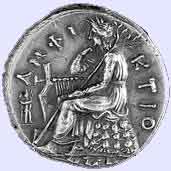
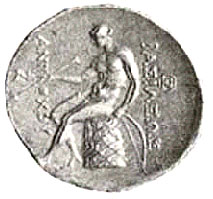 The
first coin is from Syria 246-227 BC shows the god Apollo sitting on an
omphalos stone which was a common scene found on many coins. But in
this instance the omphalos is decorated as a pine cone. The next two
coins
also show the same scene with an even greater emphasis of omphalos as
a pine cone. The pine cone as mentioned earlier represents the
fruit
from the Tree of Life.
The
first coin is from Syria 246-227 BC shows the god Apollo sitting on an
omphalos stone which was a common scene found on many coins. But in
this instance the omphalos is decorated as a pine cone. The next two
coins
also show the same scene with an even greater emphasis of omphalos as
a pine cone. The pine cone as mentioned earlier represents the
fruit
from the Tree of Life.
On a final note about baetyls. The above "pine cone" is in Vatican City.
How far away do you think you are from the ancient First Legends of Sumeria?
"FROM WHERE DID WE GET
THE WORD CHURCH?
NOTE: Most of the
following research was compiled by a fellow believer, who,
for personal reasons, has chosen not to have his name affiliated with this site.
for personal reasons, has chosen not to have his name affiliated with this site.
...The word "church" found in most (not all) Bibles is translated from the Greek word "ekklesia," and it means "called out ones." The word "church" is defined in most dictionaries as: "A building for public worship, especially Christian worship; the company of all Christians as a spiritual body." This, however, tells us nothing concerning the origin of this word and its original definition, meaning, and usage. Some theologians have erroneously stated that the word church comes from the Greek "kyrios" which means "lord," and thus "church" is those who belong to the Lord, or references the "Lord’s house." This is not, however, the origin or original meaning of the word "church."
"Church" is a very early English word that means "circle" (the shape of a circle), while the Greek word translated "church" is "ekklesia" and means "called out ones," and more properly answers to the English words: congregation, assembly or group.
...The word Bethel literally means "House of God," and was the name of a town about 17 km north of Jerusalem on the road to Shechem. Bethel was also the name of a Canaanite deity venerated at Bethel. In the ancient world Bethel is one of the camping places of Abraham and Jacob. From there Abraham sees the land God is giving him. It is also here where the dream of "Jacob’s ladder" occurs, and where God later appears to Jacob. Thus Bethel becomes a sanctuary of the patriarchs. Along with Ai, it is one of the first towns conquered by Joshua. Later, in the ninth century the town is the residence of a brotherhood of prophets centered around Elijah and Elisha. It also becomes for the Northern Kingdom the national center of worship, with its golden calf, "the sin of Jeroboam." Amos pronounces God’s judgment upon this cult (Amos 3:13-15; 5:4-7), and is expelled from Bethel by the priest Amaziah. Hosea waxes ironical about Bethel, the "House of God," that it has become Beth-aven (Hosea 5:8; 10:5), which means "the house of nothingness (or iniquity)." Josiah’s religious reform affects Bethel, where these altars and high places are destroyed (see II Kings 23:15-20).
...Dictionary of Phrase and Fable, under the entry "church" adds this:
"The etymology of this word is generally assumed to be from the Greek, kurious oikos (house of God); but this is most improbable, as the word existed in all the Celtic dialects long before the introduction of the Greek. No doubt the word means ‘a circle.’ The places of worship among the German and Celtic nations were always circular [witness circular Stonehenge, one of the most ancient stone megaliths on earth]. Compare Anglo-Saxon ‘circe,’ a small church, with ‘circol,’ a circle."" (http://hell-fact-or-fable.com/church.html)

Same
author different page:
And
the number one reason to reconsider your belief in an eternal hell:
1.a) GOD IS LOVE! (I John 4:8) Like any good parent who loves their children, discipline is always for the purpose of correction. If your children got out of line, would you lock them up in your basement and torture them unmercifully for sadistic reasons? Of course not! Those who teach that our loving heavenly Father will do so do not know the heart of God. [4] Likewise, it would be the height of hypocrisy for God to command us to love and to forgive our enemies, while at the same time unmercifully torturing His enemies for all eternity.
1.b) LOVE NEVER FAILS! (I Corinthians 13:8) If just one precious soul were to perish apart from the love of God, then that would mean that either a) God doesn’t love that individual, or b) that somehow God’s love has failed in that particular instance. And I can assure you that it is a tragic error to believe that the Love of God will fail! For God IS Love, and Love NEVER fails!
The above reasons for not believing in the concept of hell is from Gary's (the webmaster) web site: hell-fact-or-fiction which on this particular page of his web site has his top 10 reasons for not believing in the concept of hell - and I agree.
1.a) GOD IS LOVE! (I John 4:8) Like any good parent who loves their children, discipline is always for the purpose of correction. If your children got out of line, would you lock them up in your basement and torture them unmercifully for sadistic reasons? Of course not! Those who teach that our loving heavenly Father will do so do not know the heart of God. [4] Likewise, it would be the height of hypocrisy for God to command us to love and to forgive our enemies, while at the same time unmercifully torturing His enemies for all eternity.
1.b) LOVE NEVER FAILS! (I Corinthians 13:8) If just one precious soul were to perish apart from the love of God, then that would mean that either a) God doesn’t love that individual, or b) that somehow God’s love has failed in that particular instance. And I can assure you that it is a tragic error to believe that the Love of God will fail! For God IS Love, and Love NEVER fails!
The above reasons for not believing in the concept of hell is from Gary's (the webmaster) web site: hell-fact-or-fiction which on this particular page of his web site has his top 10 reasons for not believing in the concept of hell - and I agree.
 The Tree of Life and
th Ancients
The Tree of Life and
th Ancients